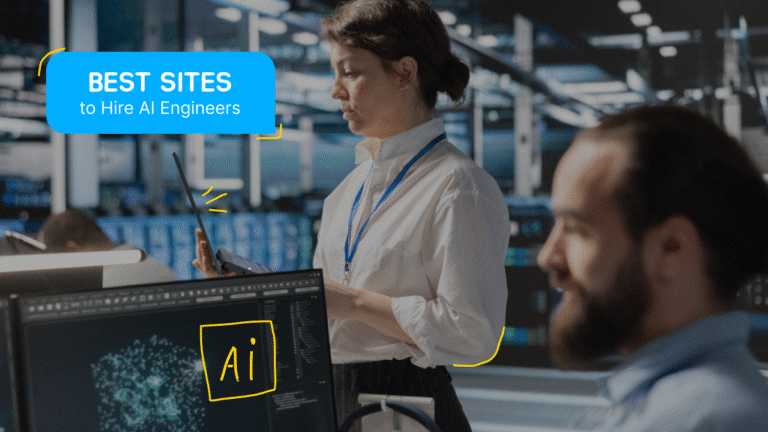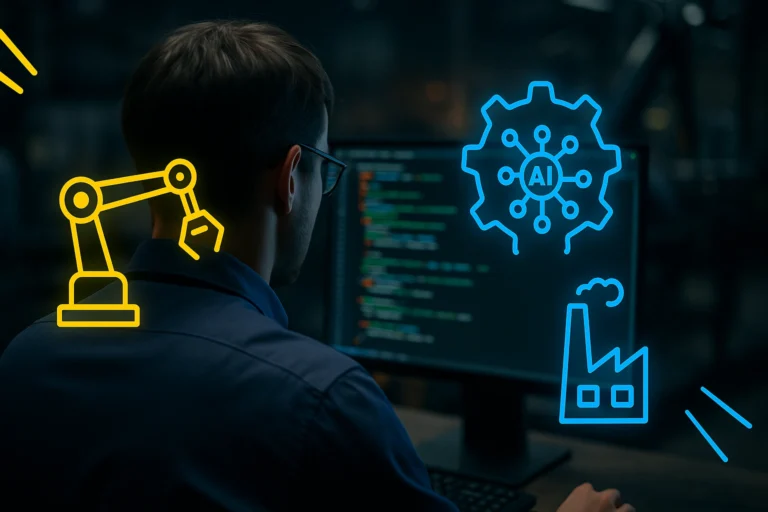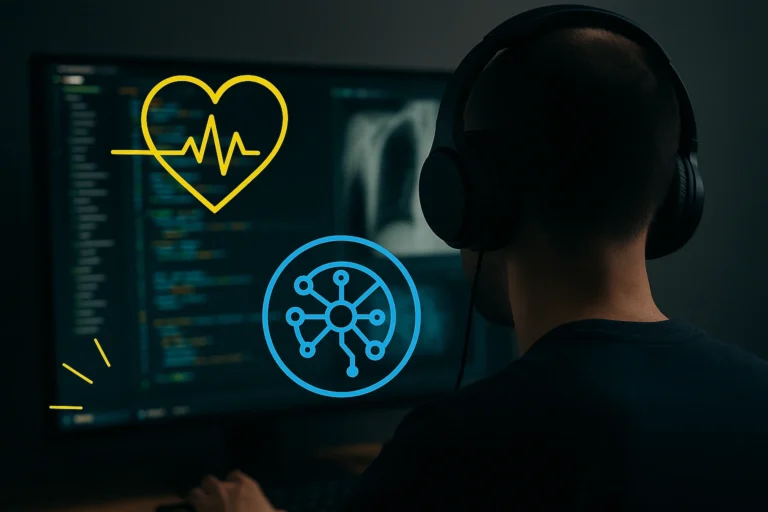How to Optimize the Team Performance with AI: Insights, Tools, and Best Practices
- What Does AI-Driven Development Mean?
- The Process of Optimizing Business Operations with AI
- Insights from Mobilunity: AI Tools Developers Actually Use
- Addressing Common Concerns and Limitations
- Best Practices for Integrating AI Into Development Workflows
- Industries Seeing the Most Value from AI in Development
- The Future of Software Developers with AI
- How to Get Started: Mobilunity’s Perspective
AI is transforming the approach to software development. From code recommendations to more intelligent testing and quicker debugging, it’s increasingly a standard component of the dev toolbox. As teams seek methods to accelerate delivery and minimize mistakes, AI provides genuine assistance – not by substituting developers, but by enabling them to work more efficiently.
The demand for developing dependable software swiftly is increasing. Companies seek clean, secure code delivered more quickly, and developers are utilizing AI to achieve that. By utilizing the appropriate tools, activities such as creating boilerplate code, identifying bugs, or producing tests can be automated or made easier.
At Mobilunity, we have witnessed this change directly. We help hire committed developers, collaborating with worldwide clients in various sectors, and are already utilizing Artificial Intelligence instruments such as GitHub Copilot, Snyk, and AI-enhanced testing platforms in their daily tasks. Although AI isn’t a magic solution, when applied correctly, it can significantly enhance the dev workflow.
In this article, we’ll explore how AI works on software dev optimization, the tools teams actually use, and what to keep in mind when bringing AI into your workflows.
What Does AI-Driven Development Mean?
AI-powered building involves leveraging artificial intelligence to enhance and optimize code with AI. This doesn’t imply that robots are independently creating entire applications; rather, it indicates that developers possess more intelligent tools that enable them to work more quickly and precisely.
In reality, AI solutions can support various domains:
- Code generation. Instruments such as GitHub Copilot or Tabnine provide code suggestions while you type, reducing time spent on repetitive activities and assisting with syntax or format.
- Testing. AI can assist in generating test scenarios, executing automated assessments, and even identifying possible problems prior to their escalation into bugs.
- Planning and estimation. Certain tools evaluate previous work to assist in estimating schedules or decompose tasks for future sprints.
- Maintenance and troubleshooting. AI-driven systems can identify abnormal patterns in logs, observe system performance, and even suggest solutions.
Crucially, Artificial Intelligence is not intended to substitute developers. It’s more akin to a strong aide that handles the repetitive or lengthy aspects of the work. Developers continue to examine code, make choices, and create systems. AI merely assists in lowering the manual workload and reducing mistakes.
At Mobilunity, we view AI as an effective instrument – not an enchanting fix. Our developers utilize it to enhance efficiency, decrease debugging duration, and receive quicker feedback on their tasks. When properly balanced, optimizing operations with AI can be both quicker and more enjoyable.
The Process of Optimizing Business Operations with AI
The Software Development Lifecycle (SDLC) is a systematic approach that directs web and mobile app development with AI from planning through to maintenance. As AI becomes essential in the development process, every stage of the SDLC is experiencing enhancements in speed, efficiency, and precision.
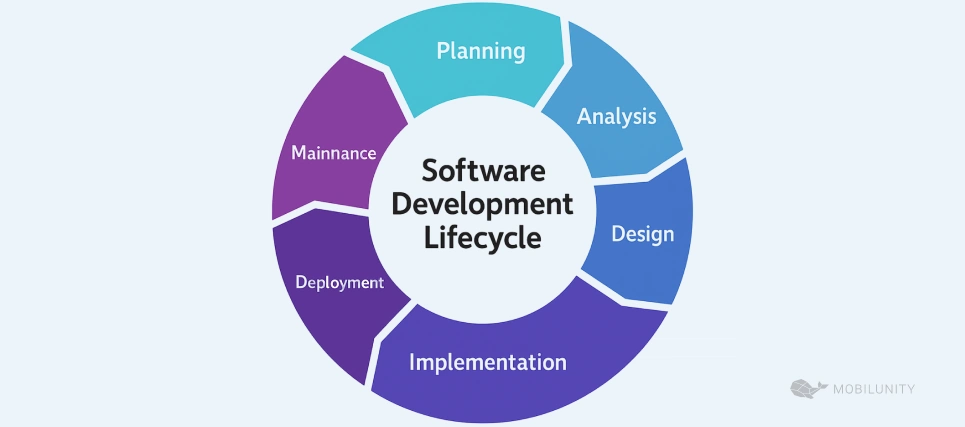
AI is not meant to take the place of developers but to assist them in working more efficiently. AI systems improve human abilities by automating processes, minimizing mistakes, and offering insights to facilitate better decision-making at all stages. Here’s how AI can enhance every stage of the SDLC:
- Planning. AI can help improve use cases, produce user stories, and develop functional requirements by quickly analyzing existing documents and grasping project needs. AI techniques assist teams in aligning project objectives from the beginning, fostering improved communication among stakeholders.
- Analysis. AI tools can detect discrepancies or deficiencies in collected requirements and suggest enhancements. Through the examination of extensive data sets, AI can assist teams in determining the most effective technologies, architectures, and solutions grounded in past successes and performance indicators.
- Design. AI assists the design stage by proposing ideal system architectures, producing design options,and even generating diagrams and pseudocode. This aids in preventing bottlenecks and guarantees that the design meets the project’s technical requirements.
- Implementation. AI-driven coding assistance tools support programmers by offering code suggestions,automating repetitive tasks, and aiding in maintaining uniformity throughout the codebase. By utilizing AI, developers can concentrate on addressing intricate issues while allowing the tools to take care of monotonous tasks.
- Testing. AI streamlines the generation and execution of tests, detecting issues and enhancing test cases for improved coverage. It can also forecast possible failure areas, guaranteeing a more dependable and effective testing procedure.
- Deployment. AI can assist in automating infrastructure management, guaranteeing uniform and flawless deployment procedures. Instruments such as Infrastructure as Code (IaC) guarantee seamless deployment to the production setting.
- Maintenance. AI improves system visibility by automatically detecting patterns and anomalies within logs and metrics. By utilizing AI, teams can foreseeably identify and resolve problems, ensuring that applications operate seamlessly over time.
By incorporating AI throughout the SDLC, teams can minimize manual tasks, accelerate delivery schedules, and enhance product quality. Nonetheless, human knowledge is essential to steer the process and facilitate well-informed choices. AI is most effective as an aid for developers, rather than as a substitute.
Insights from Mobilunity: AI Tools Developers Actually Use
Mobilunity’s developers seamlessly integrate these AI systems into their daily workflows, not just for isolated tasks but as part of their regular coding processes:
- GitHub Copilot is the most widely used tool, with 88% of developers relying on it daily for code completion and suggestions, streamlining app building by automating repetitive coding tasks.
- DALL-E and Midjourney are leveraged by design and creative teams for generating images, used for UI/UX design or creative visual assets, enhancing product designs and prototypes.
- DeepCode helps in identifying bugs early in the process, assisting the QA teams in delivering more reliable code by proactively addressing issues.
We asked developers several questions about their experience in innovation and product development with AI.
1. Which AI tools do you use regularly?
Here’s a list of the Artificial Intelligence tools Mobilunity developers use regularly, based on the survey results:
| Tool | Usage |
|---|---|
| GitHub Copilot | 88% |
| Tabnine | 5% |
| DeepCode | 5% |
| Bugsnag | 5% |
| Bitbucket | 11% |
| DALL-E | 25% |
| Midjourney | 25% |
| *developers could choose multiple variants | |
Key takeaways:
- The most widely used tool is GitHub Copilot.
- DALL-E and Midjourney are popular for image generation among creative teams.
Also, developers named Open.ai, Cloude.ai, SeperMaven, and Cursor, as tools they trust.
2. How often do you use AI tools in your daily work?
Key takeaways:
- 51% of developers use tools daily, indicating that these tools are deeply embedded into regular workflows.
- 32% use tools a few times a week, showing the growing reliance on AI as a supportive tool.
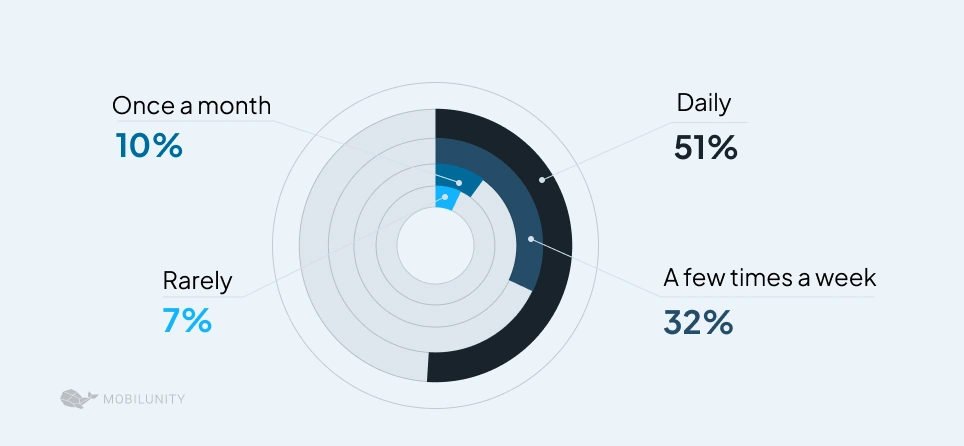
3. How useful do you find AI tools in accelerating your work processes?
Key takeaways:
- 66% of developers find AI tools to be highly useful in accelerating their workflows.
- Only 11% rated these tools as having low impact, reinforcing their value in improving efficiency.
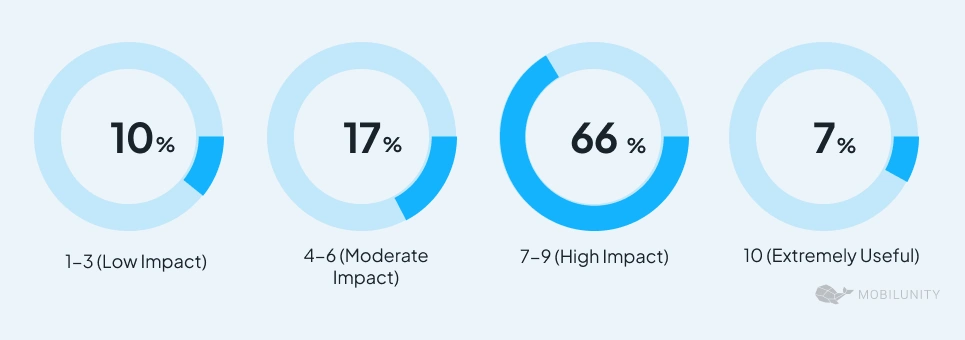
4. How do you learn about new AI tools and technologies to improve your work processes?
Key takeaways:
- 66% of developers learn about new tools from technology news and blogs, highlighting the importance of staying updated with industry trends.
- 46% get information from colleagues or team discussions, demonstrating the value of internal knowledge-sharing.
| Source | Usage |
|---|---|
| From colleagues or team | 46% |
| Professional forums and communities | 30% |
| Technology news and blogs | 66% |
| Training courses and webinars | 6% |
| Social media | 46% |
| *developers could choose multiple variants | |
5. Do you use paid versions of these AI tools? If yes, have they justified their cost?
Key takeaways:
- 39% of developers feel that paid versions of these tools have fully justified their cost, while 43% don’t use paid versions at all.
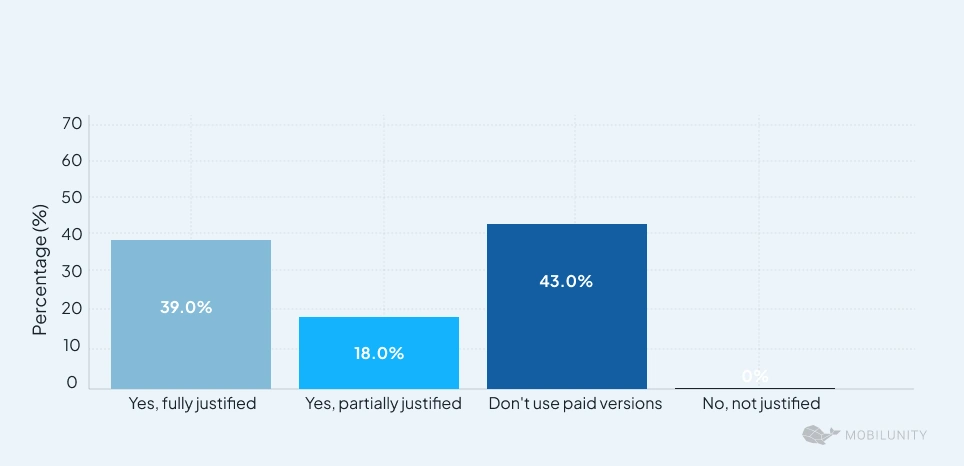
6. What is the decisive factor in choosing an AI coding assistant?
Key takeaways:
- 95% of developers prioritize functionality when choosing an AI coding assistant.
- Integration capabilities (33%) and reviews (20%) are also important factors in the decision-making process.
| Factor | Usage |
|---|---|
| Cost | 16% |
| Functionality | 95% |
| Integration capabilities | 33% |
| Reviews | 20% |
| *developers could choose multiple variants | |
Benefits of Optimizing With AI
AI-powered tools provide significant potential for enhancing productivity, quality, and predictability in software development. By streamlining repetitive tasks, improving efficiency, and offering smarter insights, AI enables developers to be more productive and concentrate on intricate work. Here’s how AI enhances essential aspects of progress:
Faster code generation and prototyping. Tools such as GitHub Copilot deliver instant suggestions, assisting developers in writing code more quickly by providing context-sensitive snippets and function proposals. This not only accelerates building but also lowers the mental burden, enabling developers to concentrate more on solving problems.
- Enhanced bug detection and fixing. AI-driven tools such as Amazon CodeGuru and DeepCode can examine code to find mistakes and weaknesses prior to them becoming problems. By examining code for possible issues, they assist developers in identifying solutions early on, avoiding expensive bugs in production.
- Improved security scanning. AI-based tools have the capability to automate security assessments by identifying vulnerabilities and recommending solutions. This guarantees that security threats are tackled early in the dev phase, resulting in a more secure final product.
- Predictive problem solving. AI can forecast possible failure points utilizing past data, enabling developers to avert issues before they occur. This proactive method of addressing issues aids in maintaining project schedules and minimizes interruptions.
- Better planning through historical data. AI models trained on previous projects and system information can help developers make more informed choices. Through trend analysis, AI can anticipate possible obstacles and provide solutions before they turn into hindrances.
Addressing Common Concerns and Limitations
Although AI provides numerous advantages in development, it’s essential to tackle several common issues and restrictions linked to its application.
Will AI replace developers?
No, AI is not meant to take the place of developers. Rather, it enhances their skills. Developers remain crucial for making high-level decisions, solving creative problems, and constructing intricate features. AI-powered tools merely automate routine tasks, enabling developers to concentrate on what is most important.
Is it secure?
The safety of AI in software building relies on the tools you select, the way you implement them, and their usage. It is essential to utilize reliable AI-driven tools and confirm that all code or data shared with AI systems is adequately protected. Data privacy and encryption techniques are crucial for preventing breaches.
What are the risks?
There are numerous risks associated with utilizing AI, including excessive dependence on the tools, biased algorithms, or incorrect positives in code recommendations. AI models rely on data for training, and if the data is defective, the outcomes may also be compromised.
Moreover, AI may overlook context, resulting in inaccurate recommendations. To reduce these risks, developers ought to implement AI with human knowledge, perform frequent code evaluations, and apply explainable AI methods to guarantee clarity and precision.
How to mitigate risks?
To mitigate the dangers of employing AI, teams ought to supervise and verify that AI recommendations are adequately assessed by skilled developers. Integrating AI with human insight is essential for striking a balance between automation and the unique creative problem-solving that only humans can offer. Moreover, continual training and modifications to the AI models can enhance precision and avoid mistakes.
By tackling these issues and employing AI ethically, development teams can fully leverage its capabilities while maintaining the software quality and safety of their software initiatives.
Best Practices for Integrating AI Into Development Workflows
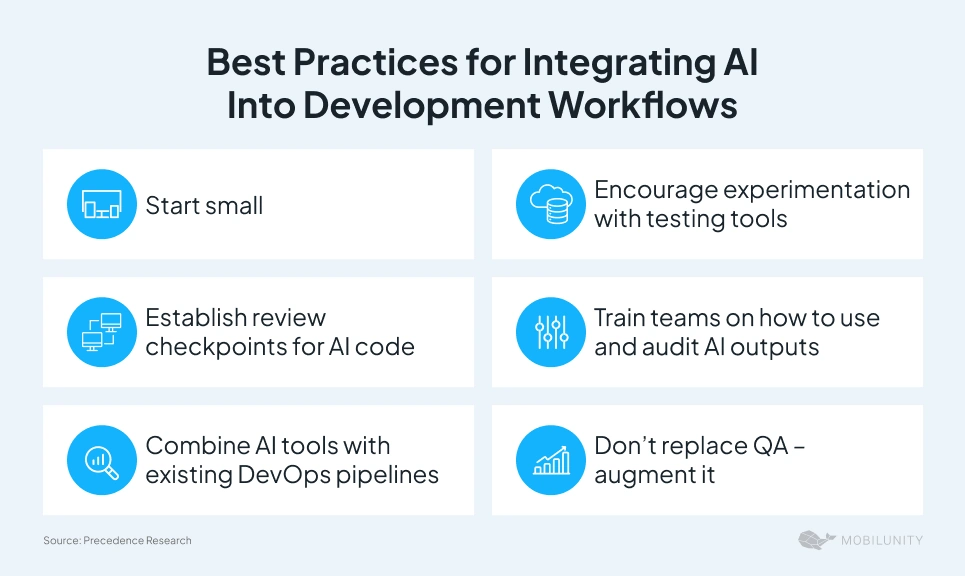
Incorporating AI into your workflow can boost productivity and elevate code quality. Nonetheless, it’s crucial to tackle this change with careful consideration. Here are several actionable measures for engineering managers and teams to effectively incorporate AI:
#1. Start small
Start by presenting tools such as GitHub Copilot or similar coding aids within a restricted context. Utilize them for designated functions like code creation or recommendations, and progressively broaden their application as teams become more familiar with the tools.
#2. Encourage experimentation with testing tools
AI-driven testing solutions, such as Testim or Applitools, can assist in automating the creation of test cases and enhancing test coverage. Motivate your team to try out these tools to discover their advantages in automating repetitive testing activities while enhancing accuracy.
#3. Establish review checkpoints for AI-generated code
AI can recommend code, but it’s crucial to ensure human supervision. Establish review milestones for developers to assess AI-produced code to guarantee quality and accuracy. This prevents dependence on AI results without verification, which may cause problems later on.
#4. Train teams on how to use and audit AI outputs
Effective training is essential to optimize your tech team with AI tools. Make sure your dev team comprehends the effective usage of tools and can assess AI outputs for mistakes or discrepancies. This training must cover recognizing the constraints of AI and methods for enhancing or rectifying its recommendations.
#5. Combine AI-driven tools with existing DevOps pipelines
AI-powered tools ought to enhance your existing dev methods rather than serve as substitutes. Incorporate AI into your current DevOps pipelines to enhance workflows and automate sections of the process like code analysis, deployment, and ongoing integration.
#6. Don’t replace QA – augment it
AI ought to assist, rather than substitute, your quality assurance (QA) procedures. Utilize AI to automate repetitive testing activities, detect possible problems sooner, and offer enhanced insights into code efficiency, while still depending on human QA knowledge for intricate testing and strategic decisions.
By adhering to these recommended practices, teams can successfully leverage AI to enhance their development workflows while ensuring quality and control throughout the process.
Industries Seeing the Most Value from AI in Development
AI is making a major difference in multiple sectors by enhancing dev cycle and strengthening product quality. Here are a few of the primary sectors gaining the most advantages from AI in software development:
- FinTech. In the fintech sector, AI is essential for detecting fraud by examining transaction trends and recognizing questionable activities instantly. AI also strengthens code security by automatically detecting vulnerabilities before they are exploited, ensuring safer financial operations.
- Healthcare. AI is revolutionizing healthcare through predictive algorithms that aid in disease diagnosis. Through the examination of medical records, AI can assist physicians in forecasting patient results, identifying early symptoms of diseases, and suggesting customized treatment strategies.
- E-commerce. AI is extensively utilized in e-commerce to create customized shopping experiences. Algorithms in machine learning examine user habits and preferences to suggest products, whereas AI-driven chatbots manage customer service questions, delivering quick and effective assistance.
- Gaming. AI is utilized in procedural generation, producing dynamic, constantly changing game settings. AI additionally aids in performance testing, assisting developers in recognizing possible problems and enhancing user experience instantaneously.
- Logistics. AI enhances logistics by forecasting demand and refining routes. Machine learning algorithms examine large quantities of data to enhance supply chain management, reduce delays, and guarantee on-time deliveries.
At Mobilunity, our teams have assisted clients in these sectors by incorporating AI into their processes, improving efficiency, and fostering innovation in multiple areas. Whether it’s optimizing testing, boosting security, or elevating user experiences, AI has shown to be an essential asset in contemporary software building.
| Industry | AI Applications |
|---|---|
| Fintech | Fraud detectionSecure code |
| Healthcare | Predictive algorithms for diagnosis tools |
| E-commerce | PersonalizationChatbot building |
| Gaming | Procedural generationPerformance testing |
| Logistics | Route and demand prediction models |
The Future of Software Developers with AI
The inquiry regarding AI’s potential to substitute software developers is prevalent as artificial intelligence keeps reshaping the dev environment. Although AI excels at automating monotonous tasks, it falls short in creativity, problem-solving abilities, and user-centered insights that are provided by human developers.
Software coders have essential traits that AI models cannot imitate, especially critical thinking, adaptability, and teamwork when dealing with distinct challenges and constantly changing project needs.
Instead of displacing software devs, AI is transforming their responsibilities. To succeed in this AI-enhanced dev setting, developers need to emphasize ongoing education and widening their expertise in fields like:
- Machine learning, neural networks, deep learning, and natural language processing
- Data science, including data analysis, statistics, and data visualization
- Programming languages like Python, R, C++, Java, and Julia – the languages utilized to build AI models
- Version control systems (e.g., Git)
- Collaborative development tools
- Software testing methodologies
- Ethical considerations, such as transparency, privacy, and bias mitigation when creating responsible AI solutions
As AI technology progresses, the demand for software coders skilled in implementing machine learning models will continue to increase. Consequently, AI ought to be viewed as an instrument that enhances human capabilities, generating fresh avenues for innovation in software development instead of supplanting the developers who bring it to life.
How to Get Started: Mobilunity’s Perspective
When creating a dedicated development team for AI-driven initiatives, it’s crucial to concentrate on these steps to guarantee success
Here is what Mobilunity offers you:
#1. Pre-vetted developers with AI expertise
- Choose developers who possess familiarity with AI-driven settings.
- Seek proficiency in utilizing AI-driven tools for software development to guarantee a more seamless incorporation into your workflows.
#2. Team augmentation services
Mobilunity assists companies in enhancing their teams by providing talented experts, delivering these advantages:
- AI expertise. Programmers skilled in embedding AI within development procedures.
- Varied skill set. Availability of front-end developers, back-end developers, quality assurance experts, data engineers, and others.
- Customized team composition. We collaborate with you to create the perfect team suited for your project’s unique requirements.
#3. Flexible team structure
Here’s an overview of how Mobilunity can assist you in forming the perfect team:
| Role | Skills and Expertise |
| Front-End Devs | Expertise in UI/UX design, responsive web apps |
| Back-End Devs | Experience with databases, server-side logic |
| QA Engineers | Knowledge in automated and manual testing |
| Data Engineers | Proficiency in data modeling, ETL processes |
#4. Full control, No full-cycle management
- Client control. You stay in command of project management.
- Mobilunity’s role. We supply the talented personnel needed to assist you in carrying out your software development processes without overseeing the complete project.
#5. Experience and expertise
- Having more than 14 years of experience, Mobilunity has formed over 150 successful teams in different sectors.
- Our selection features 5,000+ pre-screened experts, guaranteeing you access to top-notch talent for your AI-focused development requirements.
Mobilunity’s team augmentation model provides access to elite AI professionals while allowing you to maintain oversight of your project’s management, resulting in a highly effective development process.
Disclaimer: All salaries and prices mentioned within the article are approximate numbers based on the research done by our in-house Marketing Research Team. Please use these numbers as a reference for comparison only. Feel free to use the contact form to inquire on the specific cost of the talent according to your vacancy requirements and chosen model of engagement.
